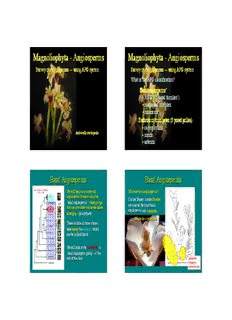
Magnoliophyta - Angiosperms - Botany Department - Home PDF
Preview Magnoliophyta - Angiosperms - Botany Department - Home
Magnoliophyta - Angiosperms Survey of Angiosperms — using APG system ‘Basal angiosperms’ ‘ ’ • ANA ( basal families ) • magnoliid complex • monocots Eudicots or tricolpates (3 pored pollen) • ranunculids • caryophyllids • rosids • asterids Basal Angiosperms We will begin our survey of angiosperms by examining the ‘basal angiosperms’ - those groups that are now shown to be the first diverging – paraphyletic! These include all those shown here except the eudicots which are the bulk of dicots We will look at the monocots - a ‘basal angiosperm group’ - at the end of the semester Basal Angiosperms What are basal angiosperms? (1) Charles Bessey’s order Ranales with most of the dicot basal angiosperms and (2) monocots Magnolia = primitive polypetaly hypogyny actinomorphic Basal Angiosperms What are basal angiosperms? Exhibit a suite of primitive character states 1. Many parts at each whorl Basal Angiosperms What are basal angiosperms? Exhibit a suite of primitive character states 1. Many parts at each whorl 2. Separate, unsealed carpels Drimys Winteraceae Basal Angiosperms What are basal angiosperms? Exhibit a suite of primitive character states 1. Many parts at each whorl 2. Separate, unsealed carpels 3. Follicle fruits Leaf-like follicles Basal Angiosperms What are basal angiosperms? Exhibit a suite of primitive character states 1. Many parts at each whorl 2. Separate, unsealed carpels 3. Follicle fruits 4. Laminar stamens Laminar stamens in yellow waterlily Basal Angiosperms What are basal angiosperms? Exhibit a suite of primitive character states 1. Many parts at each whorl 2. Separate, unsealed carpels 3. Follicle fruits 4. Laminar stamens 5. Tracheids, no vessel elements Basal Angiosperms What are basal angiosperms? Lilium (monocot) uniaperturate Exhibit a suite of primitive character states 1. Many parts at each whorl 2. Separate, unsealed carpels 3. Follicle fruits 4. Laminar stamens 5. Tracheids, no vessel elements 6. Pollen grains single pored, apertured, furrowed; not triaperturate, tricolpate ‘ ’ ANA Basal Angiosperms The ‘ANA’ group forms a basal grade (paraphyletic) Name derived from initials of members
Description: